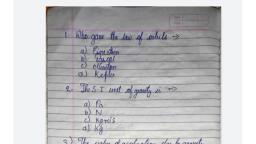Question 1 :
An object is thrown vertically upwards and rises to a height of 10 m.What is the time taken by the object to reach the highest point?
Question 2 :
Two objects of masses $ m_1$ and $m_2$ having the same size are dropped simultaneously from heights $ h_1$ and $h_2$ respectively. What will the ratio of time they would take in reaching the ground be if both of them are hollow, size remaining the same in each case?
Question 3 :
What happens to the force between two objects, if the masses of both objects are doubled?
Question 4 :
A ball thrown up vertically returns to the thrower after 6 s.What is the velocity with which it was thrown up?
Question 5 :
An object is put one by one in three liquids having different densities. The object floats with $\frac{1}{9} , \frac{2}{11} and \frac{3}{7} $parts of their volumes outside the liquid surface in liquids of densities $d_1, d_2 , d_3 $ respectively. Which of the following statement is correct?
Question 7 :
What is the magnitude of the gravitational force between the earth and a 1 kg object on its surface? (Mass of the earth is $6 \times 10^{24}$ kg and radius of the earth is $6.4 \times 10^6$ m.)
Question 8 :
The weight of an object is constant and does not change from place to place.
Question 10 :
Gravitational force on the surface of the moon is only $\frac{1}{6}$ as strong as gravitational force on the earth. What is the weight in newtons of a 10 kg object on the moon and on the earth? (Consider $ g=9.8 \ m\ s^{-2}$ )
Question 11 :
The weight of any person on the moon is about $\frac{1}{6}$ times that on the earth. He can lift a mass of 15 kg on the earth. What will be the maximum mass, which can be lifted by the same force applied by the person on the moon?
Question 12 :
A stone is thrown vertically upward with an initial velocity of 40 m/s. Taking g = 10 $m/s^2$, What is the maximum height reached by the stone?
Question 13 :
The gravitational force between two objects is F. If masses of both objects are halved without changing distance between them, then the gravitational force would become ___.
Question 14 :
How does the force of attraction between the two bodies depend upon distance between them?
Question 15 :
What happens to the force between two objects, if the distance between the objects is tripled?
Question 16 :
An object weighs 10 N when measured on the surface of the earth. What would be its weight when measured on the surface of the moon?
Question 18 :
Two particles are placed at some distance. If the mass of each of the two particles is doubled, keeping the distance between them unchanged, the value of gravitational force between them will be ___ .
Question 19 :
The volume of 50 g of a substance is 20 $cm^3$. If the density of water is 1 $g cm^{–3}$, will the substance float or sink?
Question 20 :
An object weighs 10 N in air. When immersed fully in water, it weighs only 8 N. The weight of the liquid displaced by the object will be ____.
























